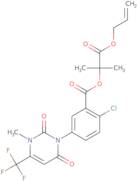Informations sur le produit
- 1-(Allyloxy Carbonyl)-1-Methylenthyl-2-Chloro-5-[1,2,3,6-Tetrahydro-3-Methyl-2,6-Dioxo-4-(Trifluoromethyl) Primidin-1-Yl]Benzoate
- 2-Chloro-5-[3,6-dihydro-2,6-dioxo-3-methyl-4-trifluoromethyl-1(2H)-pyrimidinyl]benzoic acid 1-allyloxycarbonyl-1-methylethyl ester
- 2-methyl-1-oxo-1-(prop-2-en-1-yloxy)propan-2-yl 2-chloro-5-[3-methyl-2,6-dioxo-4-(trifluoromethyl)-3,6-dihydropyrimidin-1(2H)-yl]benzoate
- Benzoic acid, 2-chloro-5-3,6-dihydro-3-methyl-2,6-dioxo-4-(trifluoromethyl)-1(2H)-pyrimidinyl-, 1,1-dimethyl-2-oxo-2-(2-propenyloxy)ethyl ester
- Benzoic acid, 2-chloro-5-[3,6-dihydro-3-methyl-2,6-dioxo-4-(trifluoromethyl)-1(2H)-pyrimidinyl]-, 1,1-dimethyl-2-oxo-2-(2-propen-1-yloxy)ethyl ester
- Butafenaci
- Butafenacil (Bsi, Pa Iso)
- Butafenacil allyl
- Cga 276854
- Cga 276865
- Voir d'autres synonymes
- Cga276854
- Fluobutracil
- Inspire
- Wc 9717
Butafenacil is an herbicide that inhibits the growth of plants by blocking the acylation reaction. It has been shown to be effective against most species of weeds and grasses, including many species resistant to other herbicides. Butafenacil is also a potent inhibitor of plant enzymes such as lipoxygenase, acetyl-CoA carboxylase, and phenoloxidase. The film-forming polymer formed by butafenacil prevents water loss from leaves and allows for better absorption of light energy by photosynthesis. This polymerization is reversible in the presence of sodium succinate, which breaks down into succinic acid and formaldehyde. Histochemical staining can be used to detect butafenacil in plant tissues because it forms a blue color with plastids that can be observed under a microscope. Butafenacil has been shown to inhibit the development of tumefaciens-mediated transformation in plants.





